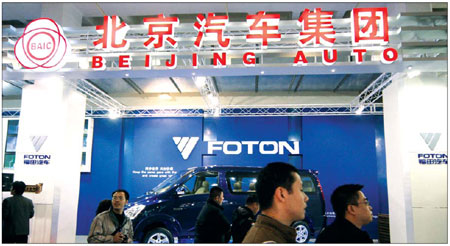motoring
BAIC buys Guangzhou Baolong
Updated: 2011-01-24 09:52
By Han Tianyang (China Daily)
|
 |
|
BAIC unit Foton is most noted for heavy trucks, but also makes small cars, part of wide diversification by the parent company. [Photo/China Daily] |
Part of Beijing automaker's blueprint for rollout of its own brand
BEIJING - BAIC Group, the partner of Daimler AG and Hyundai Motor Co, recently bought a private automaker in Guangdong province to gain a foothold in the southern market and boost its own brand cars.
| ||||
BAIC now plans to start production in South China using the Baolong facility. The site is also set to serve as the export base for BAIC's own-brand cars, the company said.
According to the agreement, BAIC will invest 5 billion yuan to construct the southern facility with a designed capacity of 300,000 vehicles a year.
Two phases
The company expects to complete the initial phase of the project with investment of 1.5 billion yuan by the end of 2012, when the plant will have the capacity to produce 100,000 light buses a year.
In the second phase, BAIC will invest 3.5 billion yuan to boost production by 200,000 vehicles, including SUVs, multi-purpose vehicles and crossovers. A sedan is also in the works.
Zhang Xiaoyu, executive vice-president of China Machinery Industry Federation, said BAIC's acquisition of Baolong meets current government policies to encourage mergers and consolidation in the domestic auto industry.
The agreement forestalls redundant plant construction and enables output to begin as soon as possible, Zhang said.
The southern plant is just one part of BAIC's blueprint to develop its own-brand vehicles. It is now building production sites in the country's southwest, central and northern regions.
Just last month, BAIC inaugurated a new plant in Zhuzhou of central China's Hunan province and rolled out its first wholly owned Beijing brand car - the BC 301Z.
The plant is designed to have an annual production capacity of 200,000 vehicles and 200,000 engines. BAIC will also produce its self-developed minibus BC 306Z at the Zhuzhou factory.
BAIC and another joint venture partner - motorcycle maker Chongqing Yinxiang Group - laid the foundation for a minivan plant in December.
The facility in Hechuan district of the southwestern metropolis Chongqing is scheduled to begin production at the end of this year with a planned capacity of 300,000 vehicles annually.
In its home city Beijing, BAIC began construction on a new facility in Shunyi district last August that is scheduled to start operation in the fourth quarter this year making its own-brand mid- and high-end cars, the C60 and C71.
Both products were developed using acquired technologies from Swedish carmaker Saab. BAIC bought the Saab 9-3 and 9-5 models as well as engine technologies for $200 million at the end of 2009.
Diverse models
The company plans to roll out more than 20 all-new passenger models and variants within the next five years, including subcompact, compact, mid and full-sized cars as well as SUVs and crossovers.
It aims to sell 700,000 own-brand passenger vehicles by 2015.
BAIC is now planning a stock market listing to raise funds for development of its own-brand passenger cars.
Last September the company took a crucial step toward an initial public offering by establishing a shareholding subsidiary - BAIC Motor Co Ltd, in which it has a 51 percent stake.
BAIC Motor's assets include the parent company's 50 percent stake in a joint venture with Hyundai, its own-brand business unit and an automotive research institute, as well as new-energy and powertrain units.
Last year BAIC sold 1.5 million vehicles, fifth among Chinese auto groups, well behind SAIC Motor Corp, Dongfeng Motor Corp, FAW Group and Chang'an Automobile Group.
Its sales revenue increased 35 percent to 158 billion yuan last year and profits are estimated to have surged 75 percent to 11 billion yuan.
Specials

President Hu visits the US
President Hu Jintao is on a state visit to the US from Jan 18 to 21.

Ancient life
The discovery of the fossile of a female pterosaur nicknamed as Mrs T and her un-laid egg are shedding new light on ancient mysteries.

Economic Figures
China's GDP growth jumped 10.3 percent year-on-year in 2010, boosted by a faster-than-expected 9.8 percent expansion in the fourth quarter.



